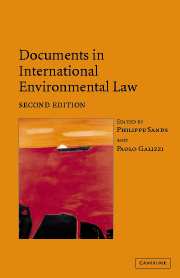Book contents
- Frontmatter
- Contents
- Preface
- PART I General instruments
- PART II Atmosphere
- PART III Oceans: global
- PART IIIB Oceans: regional
- PART IV Freshwater resources
- PART V Biodiversity
- PART VIA Hazardous substances and activities: nuclear
- PART VIB Hazardous substances and activities: pesticides
- PART VIC Hazardous substances and activities: waste
- PART VII Human rights and the environment
- PART VIII War and the environment
- 34 Convention on the Prohibition of Military or Any Other Hostile Use of Environmental Modification Techniques, 18 May 1977
- 35 Protocol I Additional to the Geneva Convention of 12 August 1949, and Relating to the Protection of Victims of International Armed Conflicts, 8 June 1977 (extracts)
- 36 United Nations Security Council Resolution 687, 3 April 1991 (extract)
- PART IX Trade and the environment
- PART X Environmental impact assessment and access to information
- PART XI Liability for environmental damage and breaches of environmental obligations
- PART XII The Antarctic
34 - Convention on the Prohibition of Military or Any Other Hostile Use of Environmental Modification Techniques, 18 May 1977
Published online by Cambridge University Press: 05 June 2012
- Frontmatter
- Contents
- Preface
- PART I General instruments
- PART II Atmosphere
- PART III Oceans: global
- PART IIIB Oceans: regional
- PART IV Freshwater resources
- PART V Biodiversity
- PART VIA Hazardous substances and activities: nuclear
- PART VIB Hazardous substances and activities: pesticides
- PART VIC Hazardous substances and activities: waste
- PART VII Human rights and the environment
- PART VIII War and the environment
- 34 Convention on the Prohibition of Military or Any Other Hostile Use of Environmental Modification Techniques, 18 May 1977
- 35 Protocol I Additional to the Geneva Convention of 12 August 1949, and Relating to the Protection of Victims of International Armed Conflicts, 8 June 1977 (extracts)
- 36 United Nations Security Council Resolution 687, 3 April 1991 (extract)
- PART IX Trade and the environment
- PART X Environmental impact assessment and access to information
- PART XI Liability for environmental damage and breaches of environmental obligations
- PART XII The Antarctic
Summary
Editorial note
The Convention on the Prohibition of Military or Any Other Hostile Use of Environmental Modification Techniques, adopted under the auspices of the Conference of the Committee of Disarmament, is designed to prevent the environment from being manipulated for military purposes. The fundamental obligation placed on Parties is to prevent the use of ‘environmental modification techniques’ for hostile purposes in a manner that causes ‘widespread, long-lasting or severe effects’ to another Party (Article I(1)). ‘Environmental modification techniques’ are defined as techniques which change, by ‘deliberate manipulation of natural processes’, the Earth's ‘dynamics, composition or structure’ (Article II). The Convention, however, permits the use of ‘environmental modification techniques’ for peaceful purposes, subject to other applicable rules of international law (Article III(1)).
The Convention creates two institutions. To assist in the co-operative implementation of the Convention, a Party may request that a Consultative Committee of Experts be convened for the purposes of gathering facts and making recommendations (Articles V(1) and V(2)). A Conference of the Parties is also established which reviews the operation and effectiveness of the Convention (Article VII(2)). In the event that a Party suspects another Party of breaching its obligations under the Convention, a complaint can be lodged with the Security Council of the United Nations, which shall investigate the matter (Articles V(3) and V(4)). If the Security Council finds that a violation of the Convention has harmed or is likely to harm a Party, other Parties are required to provide assistance to that Party should that Party so request (Article V(5)).
- Type
- Chapter
- Information
- Documents in International Environmental Law , pp. 983 - 988Publisher: Cambridge University PressPrint publication year: 2004



